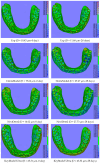A Novel 3D-Printing Model Resin with Low Volumetric Shrinkage and High Accuracy
- PMID: 40076103
- PMCID: PMC11902753
- DOI: 10.3390/polym17050610
A Novel 3D-Printing Model Resin with Low Volumetric Shrinkage and High Accuracy
Abstract
This study aims to assess and compare the shrinkage, accuracy, and accuracy stability of a novel 3D-printing model resin and eight commercially available 3D-printing model resin materials. The experimental model resin was developed by our 3D-printing proprietary resin technology. Eight commercially available 3D-printing model resins were included for comparison. The AcuVol video imaging technique was used to test volumetric shrinkage. Full-arch tooth models were printed for each model resin via digital light processing (DLP) technology. The 3D average distance between the scanned model and the designed CAD digital file was applied to determine the dimensional accuracy of the 3D-printed full-arch tooth models. One-way ANOVA and Tukey's post hoc test (p < 0.05) were utilized to analyze the average values of volumetric shrinkage and 3D average distance (dimensional accuracy). The experimental model resin showed significantly lower volumetric shrinkage (7.28%) and significantly higher or higher accuracy and accuracy stability (11.66-13.77 µm from the initial day to four weeks) than the other commercially available model resins (7.66-11.2%, 14.03-41.14 µm from the initial day to four weeks). A strong correlation was observed between volumetric shrinkage and dimensional accuracy (Pearson correlation coefficient R = 0.7485). For clinically successful modelling applications in restorations, orthodontics, implants, and so on, the new 3D-printing model resin is a promising option.
Keywords: 3D printing; accuracy; additive manufacturing; digital light processing (DLP); model resin; shrinkage.
Conflict of interest statement
Authors Long Ling, Theresa Lai, Pei-Ting Chung, Sara Sabet, Ngoc Tran and Raj Malyala are working at the company Glidewell Dental, Irvine, CA. The remaining authors declare that the research was conducted in the absence of any commercial or financial relationships that could be construed as a potential conflict of interest.
Figures







Similar articles
-
A Novel Low-Shrinkage Resin for 3D Printing.J Dent. 2022 Mar;118:103957. doi: 10.1016/j.jdent.2022.103957. Epub 2022 Jan 14. J Dent. 2022. PMID: 35038476
-
Mechanical Properties and Degree of Conversion of a Novel 3D-Printing Model Resin.Polymers (Basel). 2024 Dec 20;16(24):3562. doi: 10.3390/polym16243562. Polymers (Basel). 2024. PMID: 39771414 Free PMC article.
-
Influence of 3D printing system, postpolymerization and aging protocols on resin flexural strength and dimensional stability for printing occlusal splints, models and temporary restorations.Clin Oral Investig. 2024 Oct 19;28(11):604. doi: 10.1007/s00784-024-05998-4. Clin Oral Investig. 2024. PMID: 39425803
-
Pharmaceutical applications and requirements of resins for printing by digital light processing (DLP).Pharm Dev Technol. 2024 Jun;29(5):445-456. doi: 10.1080/10837450.2024.2345144. Epub 2024 Apr 25. Pharm Dev Technol. 2024. PMID: 38641968 Review.
-
Accuracy of 3D Printed Models Created by Two Technologies of Printers with Different Designs of Model Base.J Prosthodont. 2020 Feb;29(2):124-128. doi: 10.1111/jopr.13107. Epub 2019 Sep 9. J Prosthodont. 2020. PMID: 31498957 Review.
References
LinkOut - more resources
Full Text Sources
Miscellaneous

